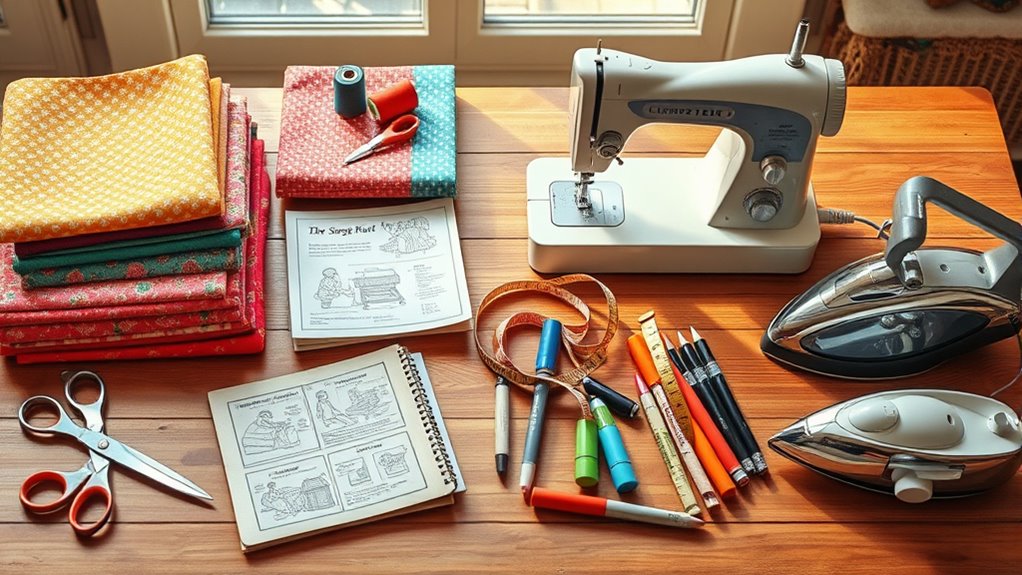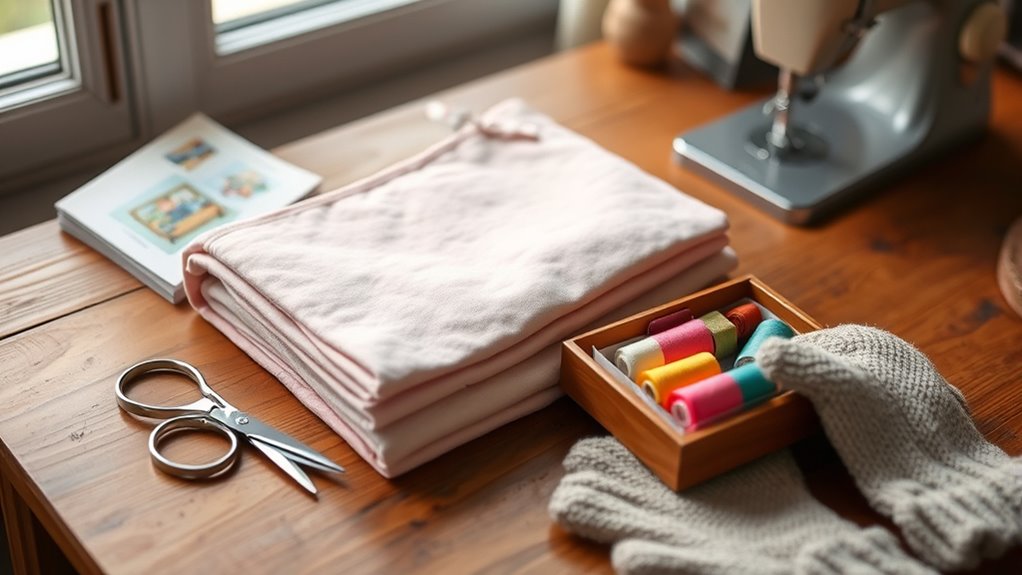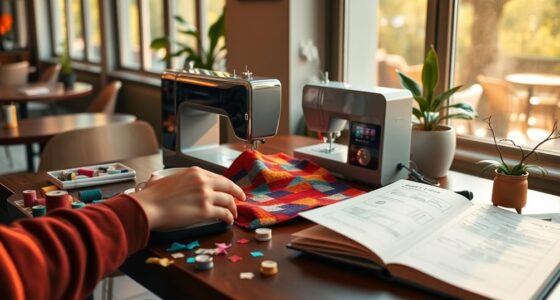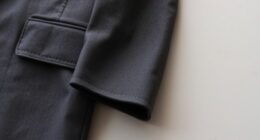To pack for your sewing retreat, start by selecting fabrics that match your projects and inspire you, keeping them well-organized by type or project. Make a detailed plan listing all the projects you’ll work on, including fabric, notions, and tools needed. Gather essentials like scissors, needles, threads, and pins, and double-check quantities. Proper planning prevents last-minute stress and helps you focus on creating. Keep exploring for tips on making your sewing retreat a smooth, enjoyable experience.
Key Takeaways
- Select fabrics that align with your project goals, color palette, and suitable textures to inspire creativity.
- Outline projects beforehand, listing fabric, notion, and tool needs to ensure efficient packing.
- Organize fabrics and supplies by project in separate containers to maintain order and streamline setup.
- Pack essential tools and notions, double-checking for completeness to avoid last-minute shopping.
- Plan your schedule and projects to promote a smooth, stress-free, and productive sewing retreat experience.

Are you ready to make the most of your sewing retreat? The key to a successful and enjoyable experience begins long before you arrive. One of the most important steps is careful fabric selection and thorough project planning. When you pick your fabrics, think about the projects you want to tackle and choose materials that suit your skill level and the look you’re aiming for. Don’t just pack random fabrics; instead, select pieces that will work well together and inspire you. Consider the colors, textures, and patterns that will bring your project to life. Having a clear idea of what you want to create helps streamline your fabric choices, making your sewing experience more efficient and enjoyable.
Careful fabric selection and detailed planning ensure a smooth, inspiring sewing retreat experience.
Project planning goes hand-in-hand with fabric selection. Before packing, spend some time outlining what projects you’ll work on during the retreat. Make a list of each project, noting the specific fabrics, notions, and tools you’ll need. This prevents last-minute scrambling or forgetting essential supplies. Break down each project into manageable steps so you can prioritize what to bring. If you’re working on multiple projects, organize them by priority or complexity to avoid feeling overwhelmed. Planning also helps you determine the amount of fabric needed, ensuring you pack enough without overloading your bag. When you have a clear project plan, you’ll be able to focus on sewing and socializing rather than searching for missing supplies.
Once your project plan is set, gather all necessary fabrics and materials. Keep your fabric pieces organized by project, either in separate bags or containers, so you can easily access what you need without digging through your luggage. Double-check that you have enough fabric for each project, accounting for seam allowances and potential mistakes. This foresight saves you from having to run out to buy more fabric mid-retreat, which can be disruptive and frustrating. Remember to also include fabric care items like pre-wash supplies, especially if your fabrics need washing before sewing. Incorporating storage solutions can further streamline your packing process and keep your supplies orderly.
In addition to fabric, make sure your project planning includes all the tools and notions required—threads, needles, scissors, pins, and any specialty items. Having a well-thought-out plan means you’re less likely to forget something crucial. It also means you can pack smarter, focusing on what truly matters for your projects. The more prepared you are with your fabric selection and project plan, the more relaxed and productive your sewing retreat will be. When you start with a solid plan, you set yourself up for a creative, stress-free experience that allows you to fully enjoy every moment of your sewing getaway.
Frequently Asked Questions
How Can I Organize My Sewing Supplies Efficiently?
To organize your sewing supplies efficiently, start by choosing smart storage solutions like clear bins or stackable containers, making everything visible and accessible. Use labeling techniques to identify each container’s contents quickly, saving you time and frustration. Keep frequently used tools nearby, and group similar items together. Regularly tidy up your space, and consider portable storage options for sewing on the go, ensuring your supplies stay neat and easy to find.
What Should I Wear for Comfortable Sewing Sessions?
When choosing sewing attire, you might think tight clothes hinder movement, but comfortable fabric selection proves otherwise. Opt for breathable, stretchy fabrics like cotton or jersey, and wear loose-fitting tops and pants to stay flexible during sessions. Avoid restrictive or overly bulky clothing, ensuring your sewing experience remains enjoyable and efficient. Prioritizing comfortable, practical sewing attire helps you focus on creating without distraction.
Are There Recommended Snacks for Long Sewing Days?
For long sewing days, you’ll want healthy snacks that keep you energized and focused. Pack energy boosters like nuts, trail mix, or granola bars, which are easy to munch on without disrupting your flow. Fresh fruit such as apples or bananas also work well to keep your energy levels steady. Avoid sugary treats that cause crashes, and bring plenty of water to stay hydrated and ready for those creative sewing sessions.
How Do I Ensure My Sewing Machine Is Travel-Safe?
Did you know that 65% of sewing machine damage occurs during transportation? To keep your machine safe, focus on machine transportation by choosing a sturdy travel case designed for your model. Verify it has padded compartments for protection, and secure all moving parts. Double-check that your machine is turned off and unplugged before packing. With the right travel case selection, you’ll prevent damage and enjoy a smooth sewing retreat journey.
What Are Tips for Managing Sewing Projects During the Retreat?
When managing sewing projects during the retreat, you should focus on fabric selection to keep things manageable and enjoyable. Prioritize your projects based on complexity or deadlines, so you don’t feel overwhelmed. Keep your supplies organized, and set aside dedicated time for each project. Stay flexible, and don’t hesitate to switch projects if needed. This approach helps you stay productive and relaxed while making the most of your sewing retreat experience.
Conclusion
Don’t let packing stress hold you back from enjoying your sewing retreat. With this checklist, you’ll feel confident and prepared, ready to embrace creativity and connection. Remember, it’s natural to worry about forgetting something, but trust yourself—you’ve got this! Focus on the joy of sewing, learning, and making new friends. When you arrive, let go of perfection and just sew, laugh, and create memories that will last a lifetime.









